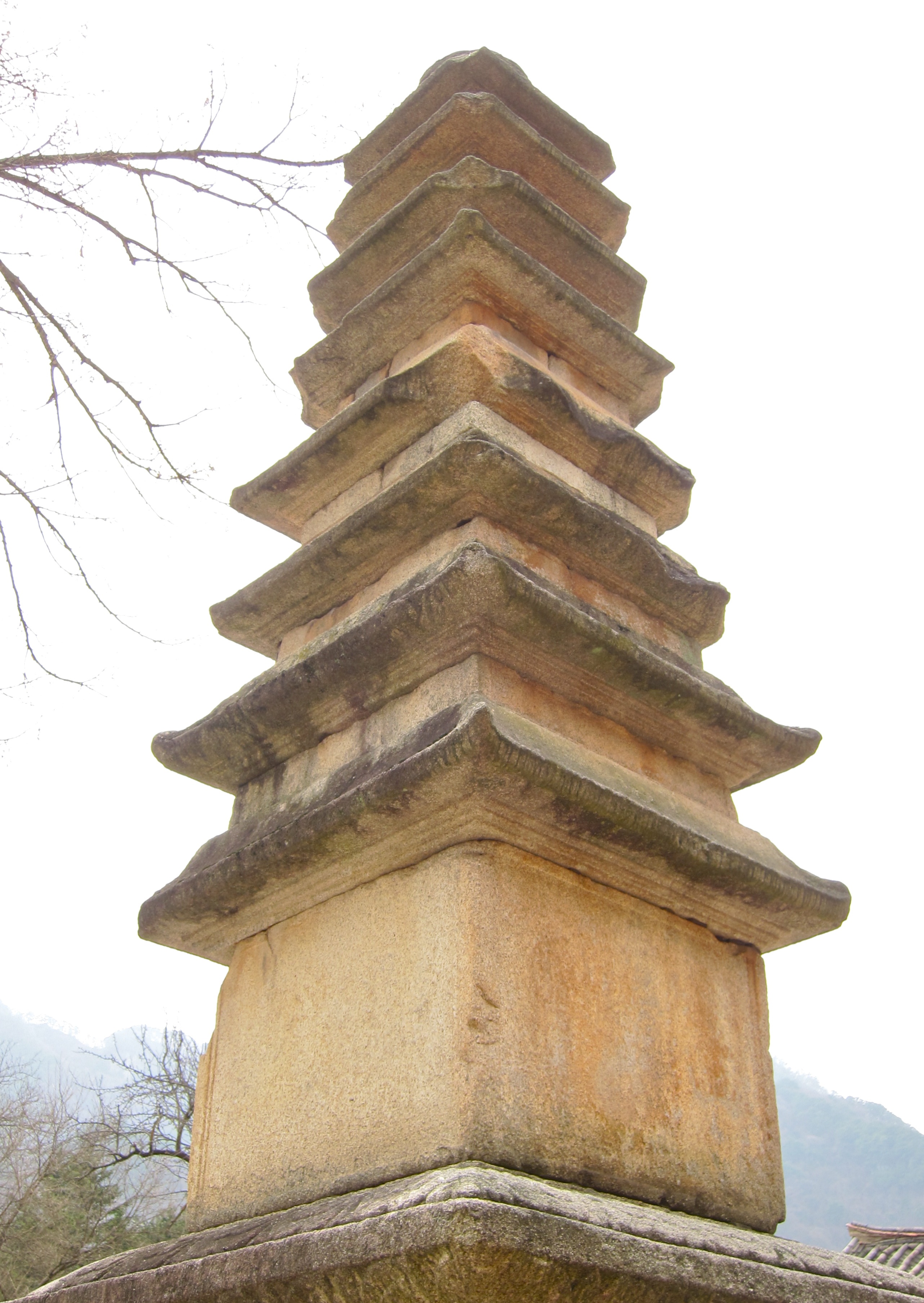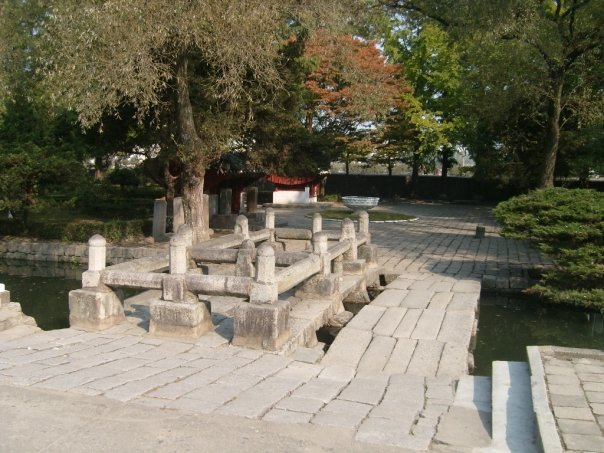|
Songgyungwan
The Songgyungwan was the highest educational institution established in Korea during the Koryo and Choson dynasties. It opened in 992. The institution consists of the Taesong Temple, Myongnyun Hall and 20 other buildings, including one of the largest wooden buildings to still exist in the DPRK. Songgyungwan is located two kilometers to the northeast of the center of the city of Kaesong. Since 1987, it has housed the Koryo Museum. History Songgyungwan was originally a palace outbuilding called known as "Taemyon". The institution was built by King Munjong, the eleventh king of Koryo and was designated as the principal teaching institute in 1089. The facility was given the name Songgyungwan in 1308. It was destroyed by fire in 1592 during the Imchin War. The institution's twenty buildings date from its reconstruction, which started in 1602; they comply with the characteristics required of a Confucian educational establishment of the period. It taught Confucianism and develop ... [...More Info...] [...Related Items...] OR: [Wikipedia] [Google] [Baidu] |
Kaesong
Kaesong (, ; ) is a special city in the southern part of North Korea (formerly in North Hwanghae Province), and the capital of Korea during the Taebong kingdom and subsequent Goryeo dynasty. The city is near the Kaesong Industrial Region close to the border with South Korea and contains the remains of the Manwoldae palace. Called Songdo while it was the ancient capital of Goryeo, the city prospered as a trade centre that produced Korean ginseng. Kaesong now functions as North Korea's light industry centre. During the Japanese occupation from 1910 to 1945, the city was known by the Japanese pronunciation of its name, "Kaijō". Between 1945 and 1950, Kaesong was part of South Korea and under its control. During the Korean War, North Korea captured the city, and the 1953 Korean Armistice Agreement left the city under North Korean control. Due to the city's proximity to the border with South Korea, Kaesong has hosted cross-border economic exchanges between the two countrie ... [...More Info...] [...Related Items...] OR: [Wikipedia] [Google] [Baidu] |
National Treasures Of North Korea
A National Treasure () is a tangible artifact, site, or building deemed by the Government of North Korea to have significant historical or artistic value to the country. History The first list of Korean cultural treasures was designated by Governor-General of Korea in 1938 during the Korea under Japanese rule, Japanese occupation with "The Act of Treasures of the Joseon dynasty". Nos. 1-50 Nos. 51-100 Nos. 101-150 Nos. 151-193 See also * Cultural assets of North Korea * Natural monuments of North Korea * National Treasure (South Korea) * Complex of Koguryo Tombs * History of Korea * Culture of Korea * List of World Heritage Sites in Asia#North Korea (1) Footnotes References * http://www.kcpia.or.kr/kcpia_mail/mail_template.php?menu=4&filetype=view&index_key=20 {{Webarchive, url=https://web.archive.org/web/20110722140935/http://www.kcpia.or.kr/kcpia_mail/mail_template.php?menu=4&filetype=view&index_key=20 , date=2011-07-22 * http://cafe.naver.com/historyexam.cafe ... [...More Info...] [...Related Items...] OR: [Wikipedia] [Google] [Baidu] |
Chŏng Mong-ju
Chŏng Mong-ju (, January 13, 1337 – May 4, 1392), also known by his art name P'oŭn (), was a Korean statesman, diplomat, philosopher, poet, calligrapher and reformist of the Goryeo period. He was a major figure of opposition to the transition from the Goryeo (918–1392) to Joseon (1392–1897) periods. Being the last great personality from the late Goryeo period, exceptional in all aspects of academics, diplomacy, economics, military and politics, and trying to reform Goryeo while maintaining the declining kingdom, he opposed to the Goryeo general Yi Sŏng-gye (the first king of the future Joseon Dynasty) who was a radical revolutionary against the rotten Goryeo Dynasty. Due to his loyalty to Goryeo, Chŏng Mong-ju was eventually assassinated by five men of Yi Pang-wŏn (the fifth son of Yi Sŏng-gye and the third king of Joseon Dynasty). Biography Chŏng Mong-ju was born in Yeongcheon, Gyeongsang Province to a family from the Yeonil Jeong clan (). He was the eldest o ... [...More Info...] [...Related Items...] OR: [Wikipedia] [Google] [Baidu] |
Sungkyunkwan University
Sungkyunkwan University (SKKU or ''Seongdae'', ) is a private research university with campuses in Seoul and Suwon, South Korea. The institution traces its origins to the historic Sungkyunkwan founded in 1398 in central Seoul. SKKU Official Brochure 2013 As the foremost educational institution during the period, it was governed by the great code of the state administration Gyeongguk Daejeon, the great code with royal assent. [...More Info...] [...Related Items...] OR: [Wikipedia] [Google] [Baidu] |
Joseon Dynasty
Joseon ( ; ; also romanized as ''Chosun''), officially Great Joseon (), was a dynastic kingdom of Korea that existed for 505 years. It was founded by Taejo of Joseon in July 1392 and replaced by the Korean Empire in October 1897. The kingdom was founded following the aftermath of the overthrow of Goryeo in what is today the city of Kaesong. Early on, Korea was retitled and the capital was relocated to modern-day Seoul. The kingdom's northernmost borders were expanded to the natural boundaries at the rivers of Yalu River, Amnok and Tumen River, Tuman through the subjugation of the Jurchen people, Jurchens. During its 500-year duration, Joseon encouraged the entrenchment of Korean Confucianism, Confucian ideals and doctrines in Korean society. Neo-Confucianism was installed as the new state's ideology. Korean Buddhism, Buddhism was accordingly discouraged, and occasionally Buddhists faced persecution. Joseon consolidated its effective rule over the Korean peninsula and saw the he ... [...More Info...] [...Related Items...] OR: [Wikipedia] [Google] [Baidu] |
Korean Confucianism
Korean Confucianism, or Korean Ruism, is the form of Confucianism that emerged and developed in Korea. One of the most substantial influences in Korean intellectual history was the introduction of Confucian thought as part of the cultural influence from China. Today the legacy of Confucianism remains a fundamental part of Korean society, shaping the moral system, the way of life, social relations between old and young, high culture, and is the basis for much of the legal system. Confucianism in Korea is sometimes considered a pragmatic way of holding a nation together without the civil wars and internal dissent that were inherited from the Goryeo dynasty. Origins of Confucian thought Confucius ( , ) is generally thought to have been born in 551 BC and raised by his mother following the death of his father when Confucius was three years old. The Latinized name "Confucius" by which most Westerners recognize him is derived from "", probably first coined by 16th-century Jesuit missi ... [...More Info...] [...Related Items...] OR: [Wikipedia] [Google] [Baidu] |
Education In Korea
Historically, Korea was differently ruled and named. The official records on organised education start with Three Kingdoms period. * ???-108 BC Gojoseon * 57 BC-668 - epoch of Three Kingdoms: Goguryeo, Baekje and Silla; in fact divided into 4 kingdoms, including also a small kingdom of Gaya * 668-926 Unified Silla and Balhae * 918-1392 Goryeo - the national civil service examinations (gwageo) established in 958; * 1392-1910 Joseon, see Education in the Joseon Dynasty * 1910-1945 Korea was under Japanese occupation, see: Education in Japanese rule Since 1945, Korea has been divided into two separate countries * For North Korea, see Education in North Korea. * For South Korea, see Education in South Korea Education in South Korea is provided by both public schools and private schools with government funding available for both. South Korea is known for its high academic performance in reading, mathematics, and science, consistently ranking abov .... {{disambiguation ... [...More Info...] [...Related Items...] OR: [Wikipedia] [Google] [Baidu] |
Neo-Confucianism
Neo-Confucianism (, often shortened to ''lǐxué'' 理學, literally "School of Principle") is a moral, ethical, and metaphysical Chinese philosophy influenced by Confucianism, which originated with Han Yu (768–824) and Li Ao (772–841) in the Tang dynasty, and became prominent during the Song and Ming dynasties under the formulations of Zhu Xi (1130–1200). After the Mongol conquest of China in the thirteenth century, Chinese scholars and officials restored and preserved neo-Confucianism as a way to safeguard the cultural heritage of China. Neo-Confucianism could have been an attempt to create a more rationalist and secular form of Confucianism by rejecting mystical elements of Taoism and Buddhism that had influenced Confucianism during and after the Han dynasty. Although the neo-Confucianists were critical of Taoism and Buddhism, the two did have an influence on the philosophy, and the neo-Confucianists borrowed terms and concepts. However, unlike the Buddhists and Tao ... [...More Info...] [...Related Items...] OR: [Wikipedia] [Google] [Baidu] |
National Museum Of Korea
The National Museum of Korea () is the flagship museum of Korean history and Korean art, art in South Korea. Since its establishment in 1945, the museum has been committed to various studies and research activities in the fields of archaeology, history, and art, continuously developing a variety of exhibitions and education programs. It was relocated to Yongsan District, Seoul in 2005. On June 24, 2021, the National Museum of Korea opened a new branch inside Incheon International Airport. Located in the boarding area of the airport in front of Gate No.22, the branch was opened in celebration of the museum's 20th anniversary. History Emperor Sunjong of Korea, Sunjong established Korea's first museum, the Imperial Household Museum, in 1909. The collections of the Imperial Household Museum at Changgyeonggung and the Japanese Government General Museum administered during Korea under Japanese rule, Japanese rule of Korea became the nucleus of the National Museum's collection, which ... [...More Info...] [...Related Items...] OR: [Wikipedia] [Google] [Baidu] |
Seoul
Seoul, officially Seoul Special Metropolitan City, is the capital city, capital and largest city of South Korea. The broader Seoul Metropolitan Area, encompassing Seoul, Gyeonggi Province and Incheon, emerged as the world's List of cities by GDP, sixth largest metropolitan economy in 2022, trailing behind New York metropolitan area, New York, Greater Tokyo Area, Tokyo, Greater Los Angeles, Los Angeles, Paris metropolitan area, Paris, and London metropolitan area, London, and hosts more than half of South Korea's population. Although Seoul's population peaked at over 10 million, it has gradually decreased since 2014, standing at about 9.6 million residents as of 2024. Seoul is the seat of the Government of South Korea, South Korean government. Seoul's history traces back to 18 BC when it was founded by the people of Baekje, one of the Three Kingdoms of Korea. During the Joseon dynasty, Seoul was officially designated as the capital, surrounded by the Fortress Wall of Seoul. I ... [...More Info...] [...Related Items...] OR: [Wikipedia] [Google] [Baidu] |
Goryeo
Goryeo (; ) was a Korean state founded in 918, during a time of national division called the Later Three Kingdoms period, that unified and ruled the Korea, Korean Peninsula until the establishment of Joseon in 1392. Goryeo achieved what has been called a "true national unification" by Korean historians as it not only unified the Later Three Kingdoms but also incorporated much of the ruling class of the northern kingdom of Balhae, who had origins in Goguryeo of the earlier Three Kingdoms of Korea. According to Korean historians, it was during the Goryeo period that the individual identities of Goguryeo, Baekje and Silla were successfully merged into a single entity that became the basis of the modern-day Koreans, Korean identity. The name "Korea" is derived from the name of Goryeo, also romanized as Koryŏ, which was first used in the early 5th century by Goguryeo; Goryeo was a successor state to Later Goguryeo and Goguryeo. Throughout its existence, Goryeo, alongside Unified S ... [...More Info...] [...Related Items...] OR: [Wikipedia] [Google] [Baidu] |









